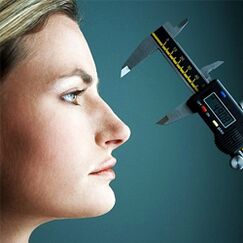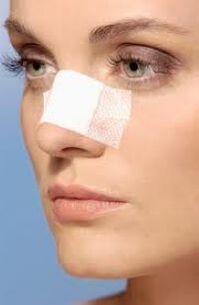The nose is the most obvious part of the face. Its shape and overall appearance determine how others perceive people. Many of us are dissatisfied with the nose: some people don’t like its size or shape, others have humps or wings that are too wide, and some people want to fix the tip of the nose, which sticks all the time, or vice versa, Will sag. With the help of one of the oldest plastic surgery-rhinoplasty, all these problems can be easily solved to satisfy the patient.
Rhinoplasty-Surgery to correct (change) the shape or size of the nose, aiming to improve its appearance, eliminate nasal breathing problems and provide patients with a state of psychological comfort.
Types of rhinoplasty
Distinguish between aesthetic rhinoplasty and reconstruction rhinoplasty.
The main goal of beautiful rhinoplasty is to correct natural "errors" by changing the shape or size of the nose, so as to make the face more harmonious and attractive. Aesthetic rhinoplasty can be complete or superficial (partial).
A complete rhinoplasty is a plastic surgery procedure in which the surgeon touches all the structural parts of the so-called external nose: bone tissue, cartilage tissue, and soft tissue. This surgery is recommended for patients who wish to reduce the length or width of their nose, change the saddle shape and remove the hump.
When the surgeon is limited to treating only certain external parts of the nose without affecting the bone tissue, partial (or superficial) rhinoplasty is an operation to correct (change) the shape of the nose. If it is necessary to correct the tip of the nose or reduce the wings, a partial rhinoplasty is required, although a complete rhinoplasty may also be required to eliminate such problems-this is determined by the doctor after examining and talking to the patient.
Reconstructive rhinoplasty is mainly aimed at solving such problems, such as eliminating breathing difficulties caused by curved nasal septum or turbinate hypertrophy. Reconstructive rhinoplasty involves restoring the appearance of the nose, damaged (for example, "sliding sideways" due to a fracture), and partial or complete loss of the nose due to injury. If you need to correct the congenital deformities of the osteochondral bones in the nasal area, you can use this type of surgery. Sometimes, plastic surgeons must use auricular cartilage or costal cartilage (in particularly severe cases) and artificial materials to literally "carve" a new nose.
Usually, patients do not have to undergo extensive surgery for aesthetic and aesthetic purposes, but to resume normal breathing, which is due to the deformation of the nasal septum during the traumatic process. Generally, post-traumatic surgery includes rhinoplasty and septoplasty (surgery aimed at correcting the nasal septum, the main goal of which is to restore normal nasal breathing).
Preparing for rhinoplasty surgery

Before deciding on surgery, the patient and the plastic surgeon discuss the future parameters and appearance of the nose, determine what the patient wants to achieve, and use a computer to simulate the final result. This method helps to "try on" the new nose to the patient's face before surgery and ensures that the patient's new appearance will not violate the overall proportions of the face, and the shape of the nose will blend harmoniously with all facial features.
It should also be remembered that if the patient is under 17-18 years of age, rhinoplasty is not performed. This is due to the growth of the body and the formation of cartilage and bone skeleton; the consequences of rhinoplasty at an earlier age may be unpredictable. But it is best to resort to rhinoplasty no earlier than 21 years old-doctors say that it is at this age that the bone skeleton is finally formed.
Features of nose correction surgery
Rhinoplasty is considered one of the most difficult plastic surgery procedures: after all, it is important not only to change the nose and make it the required size or shape, but also not to interfere with nasal breathing. Therefore, such an operation can only be performed by an experienced expert who has proven himself and has performed a good examination of the patient.
Rhinoplasty surgery can be performed in both open and closed ways at the same time. An open channel involves an incision that cuts through the skin from the outside and ends up being almost invisible. If it is a closed channel, surgical intervention can be performed from the side of the nasal mucosa (through the nostril) without any external incisions and no traces at all. Closed rhinoplasty is considered more difficult and requires special skills of plastic surgeons.
The type of access is determined directly at the time of the consultation and depends on many factors: the shape of the nose, the characteristics of its structure and the final result required. Under local anesthesia or surgery to correct the size or shape of the nose under local anesthesia or general anesthesia: the choice of anesthesiaAffected by the complexity of surgical intervention and the recommended operating time. In any case, the patient can completely get rid of the pain and will not feel any discomfort.
Postoperative period

Rhinoplasty is a serious surgical operation that not only requires the professional methods of the doctor, but also the responsibility of the patient during the recovery period. No pain after surgery. Only in the first few days, the tampon makes it difficult to breathe in the nose, causing some inconvenience to the patient.
A fixed bandage is applied to the nose and removed from time to time for skin care. Usually this bandage must be worn within 7 to 10 days. During this period, the primary edema usually disappears, and the bruises and edema under the eyes disappear. The remaining subcutaneous induration is almost invisible and disappears completely within 6-8 months. It is after this period of time that the final result of rhinoplasty is visible.
Usually, the patient is discharged from the hospital the day after the operation, but under the supervision of the doctor, he arrives at the clinic for examination and dressing change. The overall recovery process after rhinoplasty surgery takes about one month. During this period, the patient needs to wear a special bandage in the nose area, restrict physical activity and eliminate bad habits (smoking, drinking).
Patients undergoing rhinoplasty surgery must undergo a mandatory check-up with the plastic surgeon 3, 6 and 12 months after the operation.
Rhinoplasty contraindications
If the patient has a history of the following diseases, an experienced plastic surgeon will refuse to perform the operation:
- Cardiovascular system diseases;
- Coagulation disorders;
- Acute chronic diseases of liver and kidney;
- Tumor disease
- Infectious diseases;
- mental illness.
Of course, rhinoplasty is an important step in the life of a person who dreams of changing his nose and at the same time dreams of changing his own life. But many of us understand it very well: if there is one, we can even use clothing to "cover up" the flaws of the "character" or even turn it into an advantage. Then the ugly nose is the first thing that others need when looking at other people's things. One thing to note. face. Moreover, if the nose is too big or bulging, then this "spectacle" cannot be hidden in any way, it will always ruin the appearance and mood. Therefore, sometimes you need to decide whether to perform surgical intervention and correct the shape or size of your nose, instead of sighing every time you look in the mirror throughout your life.




















